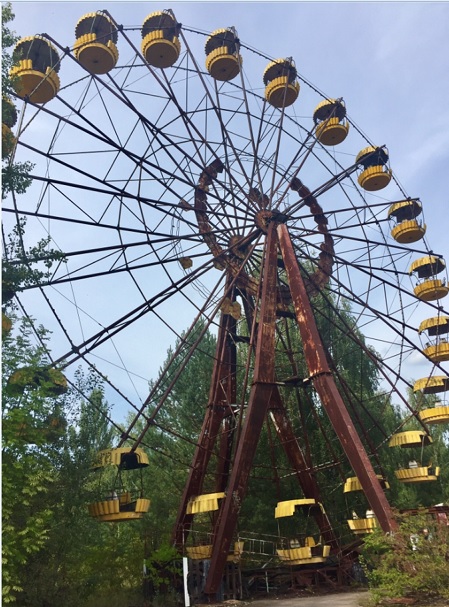Thirty-three years after reactor No. 4 melted down at the Chernobyl Nuclear Power Plant near Pripya, Ukraine — permanently evacuating entire towns, killing thousands and creating a massive Exclusion Zone — the disaster is back in the news thanks to HBO’s hit miniseries, “Chernobyl” and its accompanying podcast. With a cumulative series viewership of 8 million and counting, the buzz has even caused controversy, spurring tourists to visit the overgrown corner of Ukraine, posing for selfies in front of the now-dormant-shuttered nuclear plant, and at the ruins of Pripyat. There is debate as to whether the Exclusion Zone is becoming too commercialized.
But as a long-time travel journalist, I myself have been to the Chernobyl Exclusion Zone, though I went in 2017, before the HBO series.
I traveled to Pripyat inside the Exclusion Zone (about three hours north of Kiev) in a group of a dozen people with a local tour company, though many Western operators offer day trips there too for about $100.
The city of Pripyat, Ukraine, once had a population around 50,000, many of whom were employed at the Chernobyl Nuclear Power Plant.
Carl Montgomery | Creative Commons
The meltdown released radiation that scorched the surrounding forests red and sent a poisonous cloud across Europe, but now, decades later, experts say that it’s dissipated to the point of being safe for visitors, and the tours avoid highly contaminated areas. (There are some sites, like inside reactor four and the basement of the Hospital 126, that are still dangerous where people are forbidden to go.) A film on the van ride there assured me that I should absorb no more radiation than an average person would on a trans-Atlantic flight.
Pripyat was originally founded in 1970, along with the the massive V.I. Lenin Nuclear Power Plant, as it was officially named. Housing was needed for the men and women who would operate the facility and Pripyat was built for that purpose. The population reached 50,000 by the mid 1980s, and in better days mothers and fathers pushed baby carriages along broad boulevards where flowers bloomed, families swam at the community pool and played sports in the main gymnasium. There was even a small amusement park. The residents then went home to their apartments which were roomy, and well-furnished, by prevailing Soviet standards.
Tim Johnson
Then on April 26, 1986, a chain reaction led to a catastrophic event that released massive amounts of radioactive material, mostly through a reactor fire that burned for nine days. Slow to act, Soviet authorities eventually evacuated a 30-square-kilometer (or more than 18-square-mile) radius. Fallout drifted over Belarus and across Europe. Numbering the dead is a difficult process taking into account those who died in the initial blast, in the subsequent fire, from radiation sickness and then the cancer casualties after that. Estimates range from 4,000 by the United Nations, to 200,000 by Greenpeace.
Pripyat was evacuated within a few days after the catastrophe, but even today it persists—a ghost town with tourist traffic.
Nobody lives in Pripyat now, save for some dogs, wolves in the forest and a handful of “pioneers,” people willing to eke out a living with no electricity or running water in the abandoned buildings.
The landmarks have become warn and hollow.
The former community pool, right in the centre of town, has long since been drained and has collected a bit of graffiti on the sides, but its diving board still loomed over the deep end.
The abandoned pool in Pripyat, Ukraine
Tim Johnson
The nearby gym, once a hub of sporting activity, was in shambles. The town’s soccer stadium was so overgrown, I couldn’t even see the grandstands.
Gymnasium, Pripyat, Ukraine
Tim Johnson
Then there was the Ferris wheel, rusted and in suspended animation, every crack choked with weeds. It has become an icon of Chernobyl.

Perhaps most disturbing was the primary school, built for younger grades. The floor of one room, for some reason, was completely covered with discarded gas masks and had a single desk in the middle of it all, holding a doll’s head—perhaps posed by a past visitor, though it was unclear.
Elementary school
Tim Johnson
When we climbed to the top of a deserted 16-story apartment building at the end of the day, I could see the protective dome that now sits over reactor four, looming about a mile away just on the horizon. Between my vantage point and the plant stood a number of high rises, their windows empty, popping out of the green forest that now fills the town.
Tim Johnson
Tim Johnson

